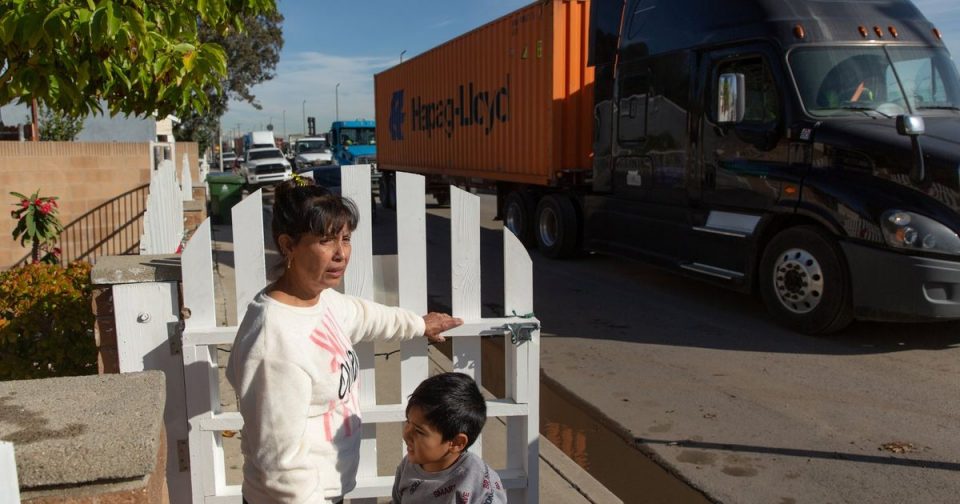LOS ANGELES — The stucco cottage looks every bit the California dream: a grassy yard and big patio, encircled by a white picket fence. Next to the front door, a Santa figurine greets visitors and a dog’s snout peeks through a window, as if an advertisement for domestic bliss.
Except.
This home is in Wilmington, a mostly Latino working-class enclave north of the Port of Los Angeles, where the effects of the supply chain crisis have spilled over in a big way. For the past several months, the street that the house is on has served as a 24-hour thoroughfare for semitrucks headed to and from the port.
“It’s like a highway,” said Imelda Ulloa, who has lived in this home for more than 20 years.
Ulloa, 57, cannot open her windows anymore because of how much noise and dust flood in. She does not invite guests over to barbecue because the din of engines drowns out their conversations. Her grandson is not allowed to play out front because it is too dangerous.
One recent afternoon, I stood on Ulloa’s stoop and counted: In 10 minutes, 44 trucks drove by, inches from her front gate.
Police and city officials ramped up ticketing of trucks in Wilmington after an increase in complaints from residents, but the sheer volume of vehicles makes it difficult to eliminate the problem.
“Obviously clearing out the ship backlog is going to be No. 1,” said Jacob Haik, deputy chief of staff for Councilmember Joe Buscaino, who represents the Harbor neighborhood.
As with many consequences of the coronavirus pandemic, said sociologist Manuel Pastor, the disruption in the supply chain has revealed something that has always been true: A small group of people pay a high price for what we view as quick and easy access to goods.
So much of the discussion around the port backlog “has focused on ‘How do we maximize the throughput?’ ” said Pastor, a professor at the University of Southern California. “But the throughput is through someone’s neighborhood.”
Wilmington residents are accustomed to dealing with the effects of living just a few miles from North America’s largest port, which handles a big percentage of the shipping containers entering the United States by sea.
But the few trucks that drove in front of Ulloa’s home on Drumm Avenue when her children were growing up did not stop them from playing tag with neighbors or skateboarding in the street.
Such activities would be impossible now. Trucks are regularly stalled outside her house, forming a colorful chain that extends tens deep.
As we sat last week in her living room, decorated with family pictures and bouquets of flowers, Ulloa and I were interrupted by a near-constant roaring of engines and honking.
It isn’t just Drumm. Elsewhere in Wilmington, residents have put up homemade barricades to protect their children from trucks. Roads have been damaged because they weren’t built to withstand throngs of heavy vehicles. In October, a container fell off a truck and crushed a parked car.
Wilmington, which is home to about 50,000 people, already has high levels of pollution from nearby oil fields and suffers some of the state’s highest rates of cancer and asthma. This latest development is unlikely to help.
“You wash your car in the morning and it’s dirty in the afternoon,” she said.
Other residents say their commutes have grown because it takes so long to merge in and out of the traffic outside their homes. Drivers delivering takeout meals or packages have to park down the street because there is no way to pull into the driveways.
“We’re living in a port — that’s what it feels like,” said Cesar Vigil, who lives next door to Ulloa. He acknowledged that the port plays a vital function, “but at what cost?”
In general, semitrucks are not supposed to drive on residential roads unless it is the only way to reach their destinations, officials say. But with a record-breaking amount of goods coming into the port, drivers may be taking shortcuts to try to pick up an extra load or could be searching for places to drop off empty containers amid a shortage of storage facilities.
Haik said that trucks in Wilmington must sometimes travel near homes because they are close to businesses. But police can check whether drivers’ manifests match the routes they take, he said.
Since September, port police officers have issued 700 moving violations to truck drivers, including for going down roads they were not supposed to, said Sgt. Glenn Twardy of the Los Angeles Port Police. They have also handed out 1,000 citations to trucks parked illegally and impounded 400 chassis that had been left in the streets.
Twardy, who has worked in the area for more than 15 years, said that while some port activity encroaching into Wilmington has always been unavoidable, “I’ve never seen it this bad.”


